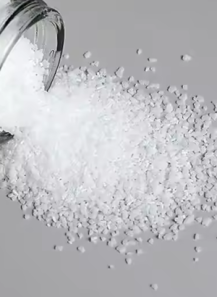Benzoic Acid (Flakes)
- Product Code: 125269
a widely used preservative in the food industry
- -
- -
- -
- -
- -
- -
- -
- -
- -
- -
- -
- -
- -
- -
- -
- -
- -
- -
| Test Name | Specification |
|---|---|
| Color | White |
| Physical | Crystal or crystalline flakes |
| Odor | Has a slight odor of benzene formaldehyde |
| Content of Benzoic acid (on dry basis) | 99.5% Min |
| Biphenyl | 100mg/kg Max |
| Residue on ignition | 0.05% Max |
| Oxidizable substances | To Pass Test |
| Carbonizable substances | To Pass Test |
| Heavy metals (Pb) | 10ppm Max |
| Chloride (Cl) | 0.014% Max |
| Phthalate | 100ppm Max |
| Loss on drying | 0.5% Max |
Benzoic acid is a widely used preservative in the food industry. Here are some key points about its use:
Properties and Mechanism
- Chemical Formula: C₇H₆O₂
- Preservative Action: Benzoic acid inhibits the growth of mold, yeast, and some bacteria, extending the shelf life of food products. Its effectiveness is maximized in acidic conditions (pH < 4.5).
Sources and Uses
- Natural Sources: Benzoic acid occurs naturally in many foods such as cranberries, prunes, plums, cinnamon, ripe cloves, and most berries.
- Synthetic Sources: It is also manufactured synthetically and used in food processing.
- Common Foods: Soft drinks, fruit juices, pickles, salad dressings, sauces, and jams.
Safety and Regulations
- Acceptable Daily Intake (ADI): The ADI for benzoic acid, set by the Joint FAO/WHO Expert Committee on Food Additives (JECFA), is 0-5 mg/kg body weight.
- Regulatory Limits: Different countries have specific limits on the amount of benzoic acid allowed in foods. For instance, the FDA in the United States permits up to 0.1% in food products.
Health Considerations
- Allergic Reactions: Some individuals may experience allergic reactions, such as asthma, skin rashes, or other hypersensitivity reactions.
- Metabolism: Benzoic acid is metabolized by the body into hippuric acid, which is then excreted in the urine.
Labeling
- E Number: In the European Union, benzoic acid is labeled as E210 when used as a food additive.
- Ingredient Lists: It must be listed on ingredient labels when added to food products.
Be the first to review this product :-)
Recommend Lab-Service
| Lab Service | Price |
|---|
Benzoic Acid (Flakes)
a widely used preservative in the food industry
Benzoic acid is a widely used preservative in the food industry. Here are some key points about its use:
Properties and Mechanism
- Chemical Formula: C₇H₆O₂
- Preservative Action: Benzoic acid inhibits the growth of mold, yeast, and some bacteria, extending the shelf life of food products. Its effectiveness is maximized in acidic conditions (pH < 4.5).
Sources and Uses
- Natural Sources: Benzoic acid occurs naturally in many foods such as cranberries, prunes, plums, cinnamon, ripe cloves, and most berries.
- Synthetic Sources: It is also manufactured synthetically and used in food processing.
- Common Foods: Soft drinks, fruit juices, pickles, salad dressings, sauces, and jams.
Safety and Regulations
- Acceptable Daily Intake (ADI): The ADI for benzoic acid, set by the Joint FAO/WHO Expert Committee on Food Additives (JECFA), is 0-5 mg/kg body weight.
- Regulatory Limits: Different countries have specific limits on the amount of benzoic acid allowed in foods. For instance, the FDA in the United States permits up to 0.1% in food products.
Health Considerations
- Allergic Reactions: Some individuals may experience allergic reactions, such as asthma, skin rashes, or other hypersensitivity reactions.
- Metabolism: Benzoic acid is metabolized by the body into hippuric acid, which is then excreted in the urine.
Labeling
- E Number: In the European Union, benzoic acid is labeled as E210 when used as a food additive.
- Ingredient Lists: It must be listed on ingredient labels when added to food products.
| Mechanism | - |
| Appearance | - |
| Longevity | - |
| Strength | - |
| Storage | - |
| Shelf Life | - |
| Allergen(s) | - |
| Dosage (Range) | - |
| Recommended Dosage | - |
| Dosage (Per Day) | - |
| Recommended Dosage (Per Day) | - |
| Mix Method | - |
| Heat Resistance | - |
| Stable in pH range | - |
| Solubility | - |
| Product Types | - |
| INCI | - |
Cart
No products
Subtotal:
฿0.00
฿0.00
Total :



